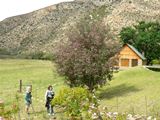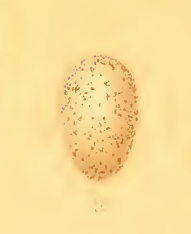Weaver species
Choose different species from drop-down list and press 'Go' button. See Full species list.Strange Weaver Ploceus alienus
IUCN: Least concern Discovery: 102Categories: fruit,
News items about species
Discovery
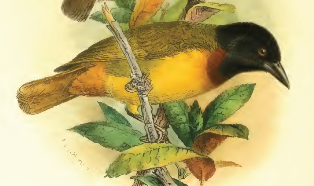
figure from Shelley (1905) 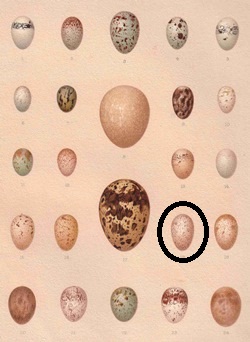
figure from Ogilvie-Grant (1910) 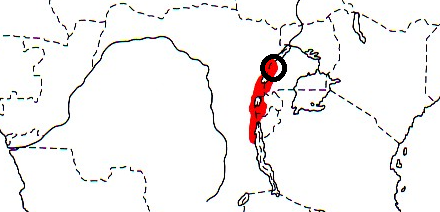
distribution, type locality circled IntroductionThe Strange Weaver was formally described by Richard Bowdler Sharpe, an English zoologist.The Strange Weaver was collected by Geoffrey Francis Archer, an English ornithologist, big game hunter and colonial official. In 1901 the 19-year-old Archer joined his uncle Frederick John Jackson, the acting high commissioner in Uganda. His uncle sent him on an ornithological collecting trip in early 1902. Archer visited Lake Albert, the Semliki valley and the Rwenzori Mountains, discovering over twenty new species and subspecies. Four specimens of the Strange Weaver were collected in the Ruwenzori Mountains between 7 and 26 February. Archer noted that this weaver was common here. The specimens were sent to the British Museum. The species was described later in the same year by Bowdler Sharpe as Sitagra aliena, where aliena means alien or strange. In fact, the English name for this species was Alien Weaver for several decades before becoming Strange Weaver. At this time there were many genera for the true weavers and Sharpe placed it in the genus Sitagra, which contained weavers with slender bills and black masks. However, this new species had a black head and throat, ie. the black area was much larger than a mask. His type description implies discussion with GE Shelley who thought this species best fit in with the Spectacled Weaver genus (Hyphanturgus), due to the slender bill and other similar characters. Either way, Sharpe considered it a strange weaver because it did not clearly fit into any weaver genus described in Shelley's book (1905, The birds of Africa, comprising all the species which occur in the Ethiopian Region. Vol. 4, Part 2). It has been claimed that "Sitagra aliena" was based on an anagram of Aline referring to Aline Jackson (nee Cooper), the aunt of Geoffrey Archer. However, "aliena" has an additional letter and thus is not an anagram. In Sharpe's type description, he clearly mentioned the classification problem and thus could only have meant to name the species as "strange". The first illustration of the Strange Weaver was of the adult, published by Shelley (1905). The next illustration to be published 50 years later by Mackworth (1955). Scientific citationSitagra aliena Sharpe 1902b, Bull. Br. Orn. Club 13 p.21, Ruwenzori, Uganda.Meaning of namesalienus, Latin: alienus, strange, foreign.First English nameAlien Weaver (Shelley 1905b).Alternate namesAlien Weaver, Reichenbach's Weaver.CollectorGeoffrey Francis Archer.Date collectedFeb 1902.Locality collectedRuwenzori, Uganda.Type specimensThe types are in the British Museum. |
The above is based on Weaver Wednesday 2, a weekly series about the discovery of each weaver species.
This species text first appeared as
Weaver Wednesday [219] - Discovery [102]: Strange Weaver on 2016-08-24
1. Basic biology
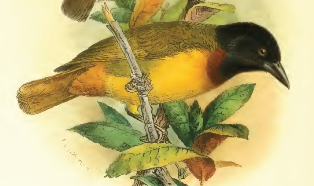
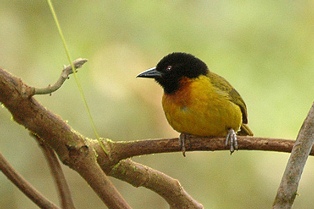
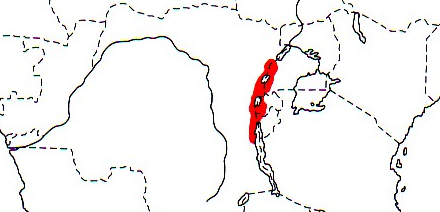
Distribution. The Strange Weaver occurs along the Albertine Rift in DR Congo, Uganda, Rwanda and Burundi (see map left, based on Birds of Africa). No subspecies of the Strange Weaver are recognised. Habitat. The Strange Weaver is a common understorey skulker in montane forest at 1500-2700 m. It generally forages in pairs low down in clearings, secondary growth and dense understorey usually below 5 m. It joins mixed-species flocks, associating particularly with Dark-backed Weavers. Food. The Strange Weaver feeds on insects and invertebrates, and also eats berries and some seeds. Breeding.
The Strange Weaver is solitary and monogamous, probably having a permanent pair bond.
The clutch size is 2. The eggs are creamy white with some grey shading, irregularly speckled with reddish-brown (figure right). Old nests may be used for breeding by the White-collared Oliveback Nesocharis ansorgei. |
The above is based on Weaver Wednesday, a weekly series about weaver species.
This species text first appeared as
Weaver Wednesday [29]: Strange Weaver on 2013-01-02
2. Breeding facts
| Pair bond Monogamous, probably with long-term pair-bond Breeding season Jan-May, possibly throughout year, in DRCongo, and in Jan-Feb, Jun and Oct in Uganda Nest site suspended 3-10 m above ground from tip of branch Nest building built by both sexes Colony size Solitary nester, although one pair may have two nests close together Clutch size 2 eggs Egg colour creamy white with some grey shading, irregularly spotted with reddish-brown Egg size average size of eight eggs 22.3 x 15 mm Incubation no information Chicks and nestling period no information |
Breeding information based on Handbook of the Birds of the World, Vol. 15.
3. Photos of Weaver Nests
 Vm 2896 |  Vm 2895 |  Vm 728 |
Thumb-nails of most recent PHOWN records - click on one to see its full record
See all PHOWN records for this species here.
PHOWN (Photos of Weaver Nests) provides valuable info on breeding distribution and colony sizes of weavers.
You can contribute by registering and submitting photos at Virtual Museum webpage.
4. Breeding distribution
Google map showing distribution (For species with small ranges you need to zoom in at the correct area to see the range):
yellow blob - range of weaver species; read more about this here.
![]() - PHOWN records with photos
- PHOWN records with photos
![]() - PHOWN records with no photos (Nest Record Cards, other records)
- PHOWN records with no photos (Nest Record Cards, other records)
![]() - Birdpix records
- Birdpix records
![]() - comments on out of range records, or interesting records
- comments on out of range records, or interesting records
![]() - type locality
- type locality
CLICK on the marker on the map to see individual record details.
5. Range changes
Not South African speciesThe above is based on Weaver Wednesday 3, a weekly series about range changes in South African weaver species.
This species text first appeared as
n/a








